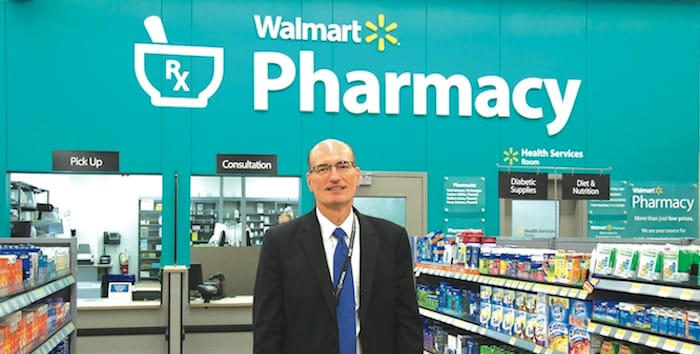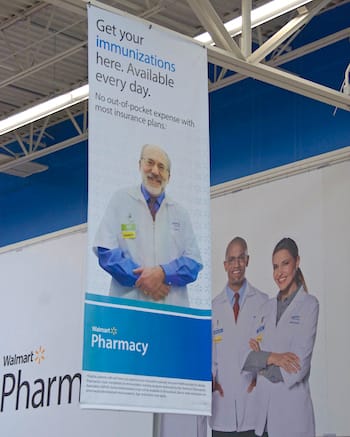
Walmart’s George Riedl: “Health and wellness can certainly be a needle mover for the company in the future.”
BENTONVILLE, Ark. — Walmart’s health and wellness division is poised to play a prominent part in the discounter’s ambitious drive to reinvent retail for an era when brick-and-mortar stores coexist with e-commerce.
Pharmacy, over-the-counter medications and vision care currently account for about 10% of Walmart’s U.S. sales. By deepening the penetration of these products and services within Walmart’s huge customer base, the company intends to grow the business by helping people live healthier, more productive lives.
“I’ve been here for just eight and a half months,” says George Riedl, a corporate senior vice president and president of Walmart’s health and wellness business, “but talking to folks who have been with Walmart a number of years, it’s clear they feel this sense of commitment and focus on health care that comes from the top of our company. Everyone from [president and chief executive officer] Doug McMillon on down realizes that with the size and scale of Walmart we can make a significant impact on the well-being of our patients and customers.
“At the same time, it’s a significant business opportunity,” Riedl points out. “Health and wellness can certainly be a needle mover for the company in the future.”
The company, consumers and the nation’s health care system all stand to benefit from Walmart’s increasing involvement in the field. By making its outlets into destinations for products and services that support health — in the latest Supercenter prototype, the pharmacy, clinic, vision care center and O-T-C section are grouped together — Walmart is giving consumers another compelling reason to visit its stores.
The retailer’s nationwide footprint ensures easy access to care, and its everyday-low pricing policy helps mitigate one of the most vexing and persistent problems in health care. Overall, the company has about 5,170 pharmacies (including warehouse club locations) and 3,000 vision centers, as well as 18 company-owned retail health clinics under the Walmart Care Clinic banner.

One example of the difference that Walmart can make is flu shots. Three years ago Walmart pharmacists didn’t offer vaccinations; last year they administered almost 2 million of them. For many patients, especially those in rural areas, the retailer’s commitment to providing immunizations in its pharmacies opened up access to an important preventive care service, and, what’s more, Walmart did so at considerably lower cost than a visit to the doctor.
“That’s been a great effort by the company the last couple years,” comments Riedl. “We made a significant impact in the marketplace, and we expect to do that again this year. We have a huge focus on it because it’s the right thing to do.”
While acknowledging that Walmart was a little late to the game with flu shots, Riedl — who spent 27 years at Walgreen Co., where, among other assignments, he served as senior vice president of pharmacy innovation and purchasing, and executive vice president of marketing and merchandising — vows the company will be a leader in the expansion of pharmacy practice going forward.
He says that one of the things that most impressed him when he joined Walmart was the dedication of its health care professionals to patient care. “Walmart has a keen focus on the patient that informs what we do. Everything from pharmacy operations to quality control and education is designed to enable our pharmacists to really focus on patient care.”
One indication of Walmart’s commitment to that vision is the clinical care team that keeps pharmacy staff members abreast of developments in a rapidly evolving field. Headed by Susanne Hiland, senior director of quality improvement and clinical services, the group, which is comprised of 250 individuals, receives intensive training at headquarters and then travels across the country to share that information with district and store-level personnel.
“We have a great team of clinical pharmacy managers that goes out in the field to help educate our pharmacy managers and pharmacists on the best ways to counsel and teach our patients about proper medication usage,” says Riedl. “Sharing that knowledge through face-to-face interactions leads to better patient outcomes.”
Riedl says Walmart is at work forging its health-related assets, which extend well beyond the core categories he oversees into such diverse departments as grocery, sporting goods and electronics, into a whole greater than the sum of its parts.
“This is a retail operations- and merchant-driven company, with a genuine commitment to what goes on in the stores,” he explains. “Our associates sense that. They see the reinvestment we’re making in the stores, and the execution of what the leadership is telling them, which accounts for the energy and momentum that we’re experiencing.”
The renaissance now under way at Walmart is built on the active engagement of employees, he adds, prominent among them pharmacists and the people who staff the retailer’s vision centers.
“Associates at all levels of the company are eager to contribute and share their insights, because they know management listens and takes what they say seriously,” Riedl explains. “That’s a big part of the reason why [Walmart founder] Sam Walton was so successful. We continue to deliver on that promise today.”









